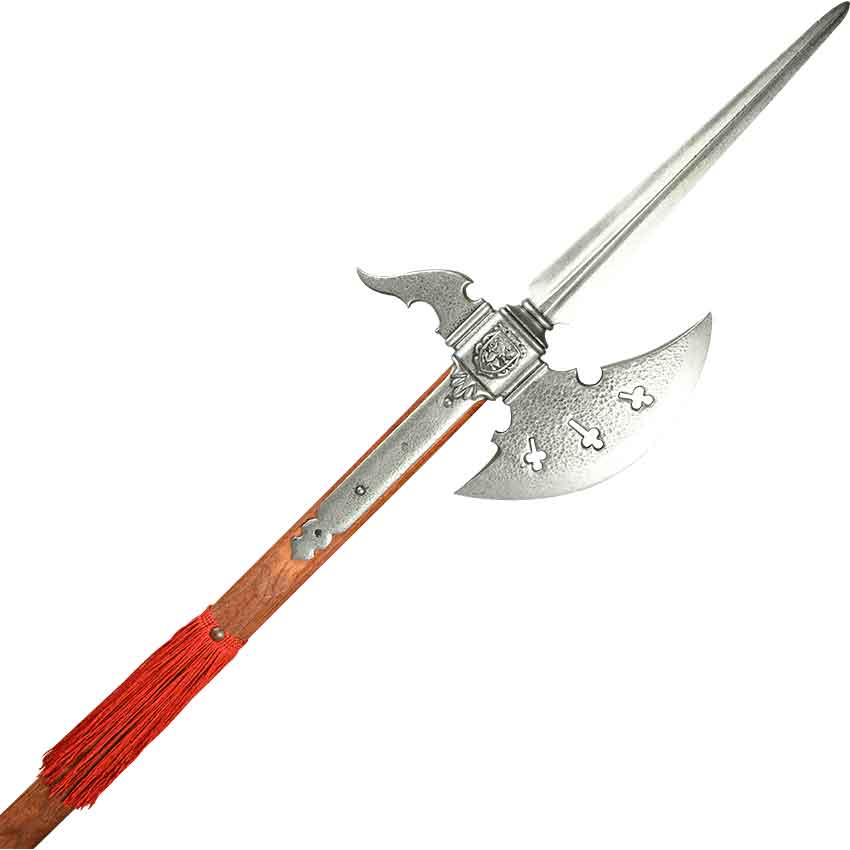~ The Halberd in the Medieval Era:
The Weapon of War, Authority, and Versatility ~
Among all the polearms used in the medieval period, the halberd stands out not just for its brutal effectiveness, but for its unique design. With an axe blade for cutting, a spike for thrusting, and a hook for pulling this weapon wasn't just deadly; it was brilliantly adaptable.
Whether used to bring down charging knights, cleave through armor, or yank enemies off their horses, the halberd earned its place as a frontline favorite of elite guards and infantry across Europe.
What Is a Halberd?
The halberd is a two-handed polearm that combines three weapon elements on a long wooden shaft:
-
Axe blade - for slashing and cleaving.
-
Spear-like spike - for thrusting, especially effective against armor.
-
Rear hook or "beak" - for pulling riders off horses, grappling, or piercing armor.
Visual Example

A real 15th-century Swiss halberd note the wide axe blade, long central spike, and curved rear hook.
Typical Specs:
-
Length: 5 to 6 feet (1.5 to 1.8 meters), sometimes longer
-
Weight: ~2 to 3 kg (4-6.5 lbs)
-
Materials:
-
Shaft: hardwood (like ash or oak)
-
Head: forged steel, often mounted with metal langets to protect the shaft
-
So yeah the halberd wasn't just an axe on a stick. It was a modular killing tool.
Origins and History
Swiss Ingenuity
The halberd originated in Switzerland in the 14th century, born from the need to counter heavily armored knights dominating medieval battlefields. The Swiss had already shown the world that infantry could challenge cavalry with pikes the halberd took it further.
The first known use in battle was around the late 1200s or early 1300s, but it became widespread by the 1400s, especially among:
-
Swiss mercenaries
-
German Landsknechts
-
City militias
-
Royal guards and palace units (more on this later)
How Was the Halberd Used?
Unlike the ultra-long pike, the halberd was:
-
Shorter, more maneuverable
-
Better for close combat
-
Lethal against both cavalry and infantry
Here's how a halberdier might use the weapon in action:
1. Chopping & Cleaving
The broad axe blade was perfect for:
-
Splitting shields
-
Crushing through mail or poorly made plate
-
Maiming limbs
2. Thrusting
The top spike was ideal for:
-
Piercing through armor gaps
-
Attacking at range
-
Defending from charging foes
3. Hooking
The rear hook or beak could:
-
Pull riders off horses
-
Hook around shields to disarm or trip
-
Smash into the back or side of plate armor
This multi-purpose nature made halberdiers more flexible than pikemen, and absolutely essential in mixed infantry formations.
Tactical Role on the Battlefield
Infantry Mainstay
Halberds were most effective:
-
In tight infantry formations
-
For defending choke points (like gates or narrow streets)
-
As shock troops paired with pikes or crossbows
A halberdier could defend against cavalry, clear out enemy infantry, and even fight up close something pikes struggled with.
Close Combat Expert
In sieges, castle corridors, and urban skirmishes, the halberd shined. Its reach was long enough for power, short enough for control. Halberdiers often served on the front lines during city defense.
Advantages of the Halberd
| Feature | Advantage |
|---|---|
| Multi-functional head | One weapon for thrust, slash, pull |
| Good reach | Not as long as a pike, but far superior to swords |
| Armor-busting power | Axe + spike combo could damage or bypass armor |
| Cheaper than full swords | Easier to produce for militia and guards |
| Highly symbolic | Adopted as a weapon of ceremonial guards, thanks to its powerful look |
Weaknesses & Drawbacks
No weapon is perfect. The halberd's strengths were clear, but it had limits:
| Issue | Problem |
|---|---|
| Not great in very tight spaces | Though shorter than pikes, still tricky in tight indoor fights |
| Required training | Using all three components effectively took skill |
| Heavy over time | Extended use could tire out a fighter |
| Outclassed by gunpowder later on | Like other melee weapons, it struggled as firearms advanced |
By the 17th century, firearms and bayonets started replacing the halberd in regular armies but it stuck around in ceremonial roles.
Halberds in Ceremony and Symbolism
Even after their battlefield days ended, halberds lived on in tradition.
Famous Units That Used Halberds:
-
The Vatican Swiss Guard - still carry halberds today
-
City militias in the Holy Roman Empire
-
Palace guards in France, Spain, and Germany
Why? Because halberds look awesome tall, impressive, and symbolic of strength, loyalty, and protection.
Even today, halberds are carried during parades, by reenactors, and in some formal military ceremonies. It's become a symbol of prestige as much as it once was a weapon of war.
Famous Historical Examples
-
Swiss Halberds - Wielded by mercenaries and shock troops in battles like Sempach (1386) and Marignano (1515)
-
German Landsknecht Halberds - Used with flair and brutal efficiency, often alongside zweihanders and pikes
-
English and Burgundian Halberds - Seen in city defense forces and palace guards
Final Thoughts
The halberd is what happens when you put every battlefield problem into a single weapon:
-
Need to unhorse a knight?
-
Need to pierce armor?
-
Need to chop a guy's legs off?
-
Need to hold a gate with a pole weapon?
It wasn't the longest, the fanciest, or the most romantic weapon of the Middle Ages but it was arguably one of the most practical.
Whether carried by a battle-hardened Landsknecht or a Swiss Guard in parade armor, the halberd remains one of the most iconic polearms in history.